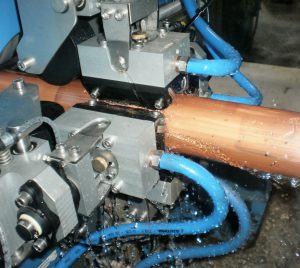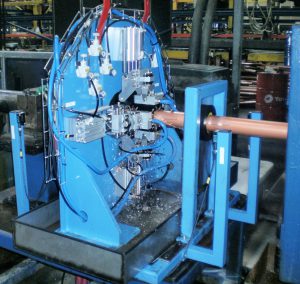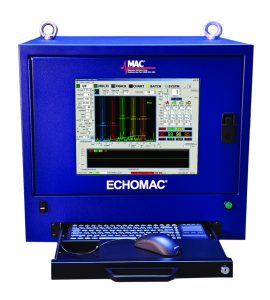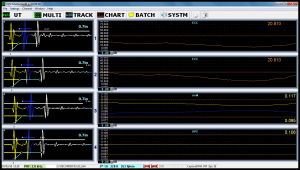ECCENTRICITY INSPECTION
UT Test for Eccentricity During Tube Drawing
Eccentricity, where the OD and ID of a tube are not concentric, is a problem that is most often created during extrusion of the tube from billet. Eccentricity in the finished product can mean wall thicknesses that don’t meet specifications, causing problems during further processing downstream.
MAC’s Echomac® UT test is applied after the extrusion process, while the tube is being drawn in a high-speed draw-production line, prior to further reduction. The test allows accurate plotting of the actual tube wall thickness and eccentricity over the entire product length. Alarm thresholds can be used to sort material into various quality grades and this data can ultimately be used to make adjustments to the production process.

UT Transducers positioned around copper tubing during test
The Echomac® FD, 4 Channel ultrasonic test for eccentricity
- 4 transducers spaced 90 degrees around the tube allow a very accurate calculation of eccentricity, assuming the external and internal extrusion dies are round.
- Unique mechanical design allows the transducers to track the tube movement accurately including normal production off-center travel.
- Transducer ride shoes use wheels to maintain consistent contact with the tube surface during the test, but the shoe assembly retracts prior to the tube back end. This type of device ensures a long life for these contact shoes.
- Bubbler water system maintains couplant for the ultrasonic signals and necessary cooling.
Four-channel eccentricity testing is a special form of four transducer operation that is designed to measure wall variation based on four independent measurements made at four fixed points, 90 degrees apart, around the tube circumference. The Echomac software derives the wall variation from these measurements.
- 2 or more alarms can be set for different eccentricity sort levels, as set by the customer.
- 1 channel alarms for a min-max thickness level, irrespective of the circumferential tube orientation under the fixed transducers.
- 1 channel can monitor the average wall.
- Operator can customize how data is presented.
- Test system responds only to eccentricity, an attribute of the wall thickness.
- Ovality, (OD variation) which may be present, is ignored.
- All production data is stored and easily retrieved, including product identification, date and stamped time.
Eccentricity measurement can be expressed in many forms. This MAC system offers a choice of the many different Eccentricity formula definitions.

Echomac® UT Eccentricity Test Head on a copper mill
ECHOMAC® FD6
For Flaw Detection, Thickness & Dimensional Measurement in Tube & Bar
- Versatile Ultrasonic tester with superior performance and versatile, intuitive operation.
- For full inspection of tubes, pipes and bars, plate and weld.
- Operate on or off line
- Upgrade and/or replace older ultrasonic testers
- Use with rotary, spin-the-tube, squirter and bubbler installations.

ULTRASONIC TECHNOLOGY IN NDT
High-speed Ultrasonic (UT) Systems enable a full volumetric examination of materials and are designed to detect surface, subsurface, internal and dimensional flaws.
This type of testing utilizes high-frequency sound waves that are transmitted throughout the material being tested in order to conduct a thorough inspection.
- Ultrasonic inspection can be used to detect surface flaws, such as cracks, seams, and internal flaws such as voids or inclusions of foreign material. It’s also used to measure wall thickness in tubes and diameters of bars.
- An ultrasonic wave is a mechanical vibration or pressure wave similar to audible sound, but with a much higher vibration frequency. For NDT purposes, the range is usually from 1MHz to 30MHz or higher.
- Depending on the test requirements, these waves can be highly directional and focused on a small spot or thin line, or limited to a very short duration.
- Two methods of UT are used for flaw detection – Shear and Compression Wave.

Instrument display showing A-scan of each thickness measurement, as well as charted data of two separate eccentricity alarms, min and max wall, and average wall

